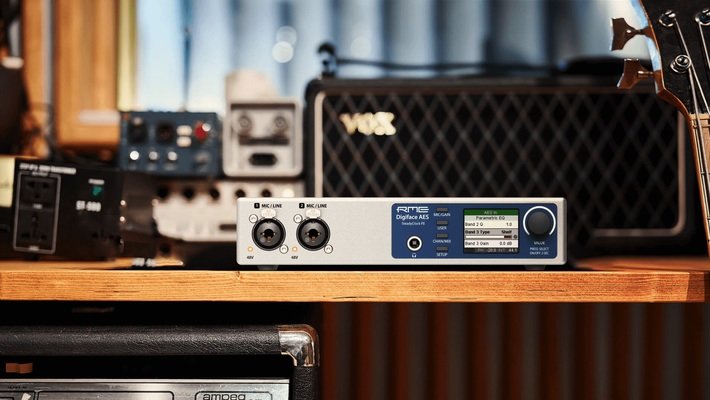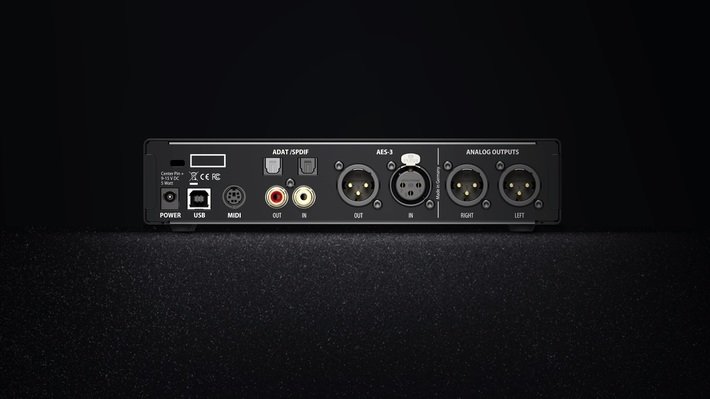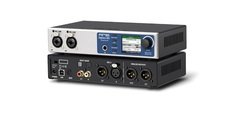The latest Digiface AES is a professional, bus powered 14 input and 16 output channel USB 2.0 interface with 2 Mic/Line universal analog input channels and 4 analog output channels (2 XLR, one TRS phones) complementing its digital I/O section. With an excellent set of digital connectivity, SteadyClock FS, full stand-alone operation and built-in parametric EQ, the Digiface AES shines as the perfect all-in-one solution for recording and playback of digital and analog sources, as well as flexible playback/monitoring via TotalMix FX.
Overview
Connectivity
- 2 x digitally controlled microphone/Line inputs featured with "Autoset"
- 2 x balanced Line outputs, level switchable +19 dBu / +13 dBu / +4 dBu
- 2 channels 192 kHz Record/Playback via AES (XLR)
- 2 channels 192 kHz Record/Playback via SPDIF coaxial (RCA)
- 2 channels 192 kHz Record/Playback via SPDIF optical
- 8 channels 48 kHz Record/Playback via ADAT optical
- 1 x MIDI I/O, 16 channels high-speed Low-Jitter MIDI
- 1 x low impedance headphone output
- USB 2.0
- USB Bus-powered
Features
Convenient, direct access and control of all features and the device is available directly from the front panel. Four keys and the encoder, the high-resolution and clear color display, and a well thought-out menu structure allow for quick changes and configuration of the device.
Six different device setups can be stored into internal memory. With these the interface transforms into totally different devices by the simple click of a button, which is especially useful in stand-alone mode. Furthermore TotalMix FX can also be controlled externally via MIDI.
The Digiface AES also includes the powerful digital real-time mixer TotalMix FX. It allows fully independent routing and mixing of input and playback channels to all physical outputs. Independent stereo submixes plus a comprehensive Control Room section offer unrivalled monitoring capabilities and unsurpassed routing flexibility.
TotalMix Remote, enhances the power of RME interfaces by enabling remote control via iOS, PC or Mac. With a straightforward set up process — simply enter the IP address of the computer you would like to control with TotalMix Remote and get going — users can quickly adjust any aspect of TotalMix FX on a host system while walking around the studio with their tablet, or from a control room located elsewhere in the facility.

Sample Rate Converter (SRC)
The Digiface AES has three digital inputs that can be used simultaneously: AES, SPDIF coaxial and SPDIF optical. SPDIF as a consumer format is often not synchronizable, a simultaneous use of the inputs is not possible.
A stereo Sample Rate Converter (SRC) included in the Digiface AES solves this problem. An SRC not only allows real-time conversion of the sample rate, but also clock decoupling. The high- quality converter works practically lossless and with low latency (2.5 ms), there are no audible artifacts or noise during the conversion.
Via the Settings dialog, or directly in the device menu (only in CC and stand-alone mode), the SRC is assigned to one of the three inputs. Ref- erence is the current clock (display Current). This can be either Internal or one of the three digital input signals.
The SRC offers a maximum conversion rate of 1:7 or 7:1, respectively. Thus, 192 kHz can be converted to any sample rate down to 32 kHz, and vice versa.
However, an SRC serves not only the conversion of the sample frequency, but also the clock decoupling, i.e. adjustment of two equal sample rates to full synchronicity. By means of SRC any non-synchronizable device (CD player, DAT etc.) can be used in combination as if it were syn- chronizable. The SRC decouples the input clock from the reference clock, and thus allows the merging of different clock sources without any clicks or dropouts.
A jittery input signal might degrade the quality of the sample rate conversion. The Digiface AES therefore has a second SteadyClock exclusively for the current SRC input signal to make the sample rate conversion process as reliable and transparent as possible.
Like the Digiface AES, the SRC only supports Single Wire mode.
The SRC is not available to the optical input’s 8-channel ADAT format.
Typical applications for the SRC are real-time sample rate conversion, and clock decoupling of non-synchronizable sources. But an SRC is also good for digital sources in other respects, be- cause it guarantees continuous clocking without disturbances. An example from practice: DAT tapes often show little formatting errors between the various recorded takes. There can also be tiny snippets with other sample rates between the recordings. An SRC reliably converts this patch- work into a continuous, permanently valid data stream with a fixed sample rate. Even if there are unformatted spots on the tape, or the DAT is being stopped or switched off, the Digiface AES receives a constant signal (which in this case does not contain audio information).





